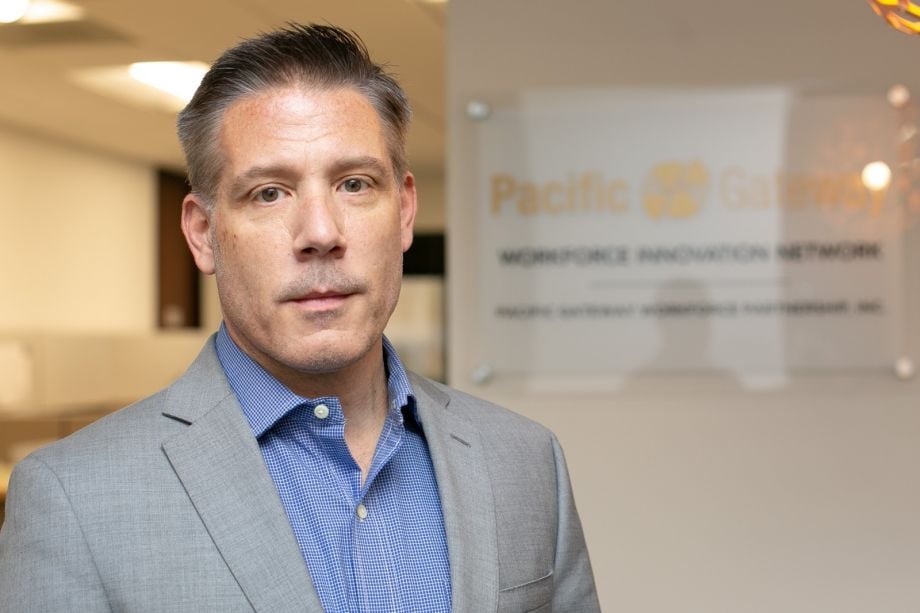CalFLEXI is a gig-work platform run through public agencies and nonprofits. In a pilot that ran through the late 2020 peak of the pandemic, CalFLEXI offered frontline workers in Long Beach childcare provided by professionals. Users of the program could pay their sitters a comfortable hourly wage on a sliding scale based on the sitter’s level of experience and the family’s income, with lower-income families getting childcare at no cost.
This is your first of three free stories this month. Become a free or sustaining member to read unlimited articles, webinars and ebooks.
Become A MemberEDITOR’S NOTE: This story is part of a series called The Future of Work, which explores what work will look like as we move beyond the pandemic. It’s produced with funding from the William Penn Foundation and the Lenfest Institute for Journalism. Next City is one of more than 20 news organizations producing Broke in Philly, a collaborative reporting project on solutions to poverty and the city’s push towards economic mobility. Follow us at @BrokeInPhilly.

During the peak of the Great Depression, 25% of the American workforce lost their jobs, a staggering figure that would go unrivaled for a century. In May 2020, the country came close: up to 16% of Americans were out of work, beating a high of 10.6% during the Great Recession. In the 1930s, the Roosevelt administration’s response was to create millions of new jobs through the Works Progress Administration, which included unusual branches like the Federal Art Project and the Federal Writers’ Project. Nearly a century later, the city of Long Beach is approaching unemployment with a provocative solution fit for the 21st century: gig work. And advocates of this government-run gig work platform say it could work anywhere, including Philadelphia.
A city of about 463,000, Long Beach falls both geographically and economically between its ritzy coastal neighbors, Huntington Beach and Palos Verdes, and nearby San Pedro, a working-class port town. In recent years, Long Beach has become a more affordable housing option for young families in Los Angeles County than in LA proper, bolstered by a strong public school system and a popular progressive mayor, Dr. Robert Garcia. During the pandemic, Long Beach introduced select residents to CalFLEXI, an unconventional gig work platform run through public agencies and nonprofits. Through the late 2020 peak of the pandemic, CalFLEXI offered frontline workers in Long Beach childcare provided by professionals. Users of the program could pay their sitters a comfortable hourly wage on a sliding scale based on the sitter’s level of experience and the family’s income. Thanks to the program’s funding, lower-income families received childcare through the program for free.
Those who follow gig work may view CalFLEXI — which is to say, a government-run gig-work platform — with some suspicions. In California, where the Uber-and-Lyft-funded passage of Prop. 22 stripped gig workers of their hard-won benefits, should local governments focus on imitating gig-work platforms, rather than regulating them? Would the program continue to normalize a model of work that is inherently insufficient for employees, promising less work and comfortable pay while delivering the opposite? What about health care, a pension, or other traditional job benefits?
CalFLEXI’s vision relies on an understanding of gig work as a supplement to an already-existing income. Within the schema of that assumption, its program is unarguably more humane than its privately-owned counterparts. Whether or not CalFLEXI’s workforce was using the program as additional income on the side or as a wholesale replacement to lost full-time work is unclear: Next City was unable to reach anyone for comment who had found employment through the CalFLEXI platform.
For years, thousands of Long Beach residents found work at the nearby Boeing production facility, where they produced its C-17 planes. In 2014, the company announced that it would no longer be buying that model, leaving an employment vacuum in its wake. At that point Nick Schultz, deputy director of the city of Long Beach’s economic development department, started considering alternatives.
Schultz found that the median Long Beach income was low enough to raise questions. There wasn’t, as he tells Next City, “abject poverty or homelessness in the city of Long Beach,” unlike in other California cities, such as LA or San Francisco. But based on the official data, “people really couldn’t afford to be here.” So, how were locals getting by? He surmised that many supplemented their incomes on the side. What if the government also offered this kind of side hustle — what’s now popularly known as gig work — for Long Beach residents? In late 2015 or early 2016, a colleague of Schultz’s connected him to Wingham Rowan, a wonkish British entrepreneur with a unique approach to a piecemeal labor economy.
Since the late ‘90s, Rowan has been preaching a gospel many have been unwilling to hear: The nature of employment is changing, and the worker is as screwed as ever. The answer? An alternate model of gig work, powered entirely by the government and nonprofits. One 2015 profile in The Guardian quoted Rowan as saying that his project is all about “securing the vision of Karl Marx through the means of Adam Smith.”
“Your perception is [that gig work] is low-quality, precarious, minimal benefits, very little control for the workers,” says Wingham Rowan, a wonkish British entrepreneur. “And you’re right. It is all of those things.” He argues that this is type of gig work the unregulated private sector has created, but that “gig work,” broadly, is not inherently exploitative.
Over Zoom, Rowan — who is based in the UK — explains that his focus was always on the overlooked “20% or so of adults [in the UK] who cannot do a job:” the chronically ill, for example, or caregivers for disabled and/or elderly family members, or students — people whose daily lives fly in the face of a traditional 9 to 5. “You literally can’t be waking up each morning thinking, ‘Well, can I go to work today? Depends if my back pain goes away,’” argues Rowan. This overlooked faction of the population tends to be excluded from traditional government welfare programs and philanthropic projects. Rowan’s nonprofit, Beyond Jobs, seeks to remedy that.
At its heart, Beyond Jobs offers its partners both a tech platform — what in the U.S. manifested as CalFLEXI — and a philosophy: the provocative notion that the government could repurpose popular technology to solve persistent social issues; in this instance, low wages and/or unemployment.
In a 2021 profile in The New Yorker, Rowan spells out how Beyond Jobs could be scaled up infinitely, imitating the private sector model of gig work in form, but with the government taking a much smaller cut of an employee’s earnings, and even offering benefits. Some gigs could be constructed to offer workers additional job experience, like, as author Nick Romeo writes, “a government-run mentor-mentee program,” leaving enough time for the worker to sign up for hourly shifts through the same site. Childcare providers could explore how related work or additional certifications could increase their salaries. The work itself could be more meaningful, with workers finding gigs in public-sector employment such as home nursing and classroom assisting. “Instead of trying to create new jobs wholesale,” Romeo explains, “the system could provide work an hour at a time.”
Though CalFLEXI had been in the works for years leading up to the pandemic, its timing was perfect: In the spring of 2020, sign-ups to work for apps such as Instacart and Upwork skyrocketed, with Instacart onboarding 300,000 new drivers in a single month. In 2017, the Bureau of Labor Statistics estimated that some 55 million Americans were employed in some capacity to do gig work — about 34% of the national population. Today, some — including Wingham Rowan — estimate that that number could be as high as 50% for 2021.
Rowan is aware of the downsides of gig work. “You have a perception of how gig work works at the moment, and your perception is it’s low-quality, precarious, minimal benefits, very little control for the workers, and probably a dead end,” he says. “And you’re right. It is all of those things.” That is the gig work the unregulated private sector had created, he argues, but “gig work,” broadly, is not inherently exploitative.
With the advent of CalFLEXI, the city of Long Beach aims not to collaborate with or regulate gig companies, but to compete with them.
So, how did the program actually work? In late October 2020, the City of Long Beach rolled out a pilot program called “Work LB” to provide free childcare to eligible city residents. The program was funded by the CARES Act, and ran on a trial basis through the end of 2020. Local government teamed up with Skills4Care, a local childcare nonprofit, to source qualified childcare workers, including those with special needs training. Those workers signed up for CalFLEXI to get gigs booked. According to Schultz, childcare providers for CalFLEXI were paid around $21 to $27 an hour, based on their level of experience. The intermediary (here, Skills4Care) took about $3 to $4 off of the top, meaning that the lowest pay rate was about $17 hourly — above Long Beach’s $13 to $14 hourly minimum wage and the estimated $9 an hour that rideshare drivers earn.
Crucially, all of these childcare providers are given full employment status by Skills4Care, meaning that they receive health care and other benefits. In some cases, families could even request that a family member or friend provide the childcare for them, in which case the worker would be hired by Skills4Care. Their hours would then be booked and paid for through the CalFLEXI site. Skills4Care would run necessary background checks and provide COVID-19 safety training for its new workforce. Workers and eligible families would then use CalFLEXI’s online platform much like a traditional gig-work site: selecting desired hours, choosing preferred providers, paying them through the site when applicable, and offering a rating.

Joy is a parent who used CalFLEXI during its pilot phase. She balances a full-time job and several side hustles. She believes that all parents would reap mental-health benefits from having “an hour or two a day, or even a week, just to sit down on a swing and not worry about anything,”
An actual person would review all submitted hiring requests, and would call the families in question if a given provider was not available, or negotiate different schedules between worker and parent as necessary. Joy, a mom of three who used CalFLEXI, described how this representative allowed her to hire a sitter for a full eight hours so long as they had a lunch break: another instance of bringing traditional workplace accommodations to the gig work model.
Anyone who’s ridden in an Uber is familiar with being nudged by the app to give a driver a 1-5 star rating after the trip. Because CalFLEXI is in the public sector, users of the platform — which is to say, the person receiving the service — are trained to consider ratings differently. As Rowan describes, CalFLEXI workers are given between one and six stars, where the stars correlate to the amount of experience they have with their employer. Their star rating would increase to signify that the responsibilities of the worker had increased: a hotel worker could start off as a single star, then rise to two stars after receiving training to work the reception desk. Three stars could be awarded after the worker had been shown how to do room checkout. As Rowan describes, a two-star rating is “not you saying ‘He’s crap,’ it’s you saying, ‘I’ve invested in him a bit more.’”
In total, 103 experienced childcare providers were employed by Skills4Care. They came from work as substitute teachers or youth leaders, but had lost their jobs during COVID. 127 local families applied for help from the CalFLEXI program, and all received childcare through it: first a baseline of 40 hours, with more available as necessary. Between late October and the end of the year, 3,765 hours of childcare were booked through the site.
Joy herself fits the model initially described by Nick Schultz: She’s a Long Beach resident with a job in workers’ compensation, with side hustles in notarizing and tax preparation. She has three kids, the youngest of whom is just ten months old. As we spoke, she rocked on a swing in her verdant Long Beach backyard, effusive about the program. Twice in the duration of our 20-minute phone call, she repeated that CalFLEXI should be made available in every state in the U.S.
“I think with parents, especially with moms, if they can get, like, an hour or two a day, or even a week just to kind of sit down on a swing and then just not worry about anything,” she said, their mental health would dramatically improve. She continued, “‘Cause, I know my kids are in there and they’re safe and there’s someone who’s responsible, who’s vouched for, that’s watching them… If you would give me a tax credit, or if you would give me some money, … I would rather that you give me … like, five hours a week [of childcare], so I can just sit and just not think of anything.” She laughed. “I think the country would be better if the moms are not as stressed; that’s what I’m actually trying to say.”
What would it take to get other cities to implement something like CalFLEXI? Beyond lingering questions about gig work and whether or not it really can provide a livable income, the cost and the government’s ability to roll out functional technologies are two particular sticking points.

Nick Schultz is the deputy director of the city of Long Beach’s economic development department.
When I ask Rowan what it would take to get something like CalFLEXI going outside of Long Beach, he is confident: “The frustrating thing is that it’s so easy to do!” Beyond Jobs’ technology could be implemented in Pennsylvania “tomorrow. It’s not a problem.” The biggest hurdle wasn’t the technological back end; it’s “market making,” or creating sufficient interest among local employers to hire the inevitable masses who would use the site. Without that demand, those who rushed to sign up for their local CalFLEXI would be instantly disappointed by the lack of job offerings and write the program off as a bust. Market-making means figuring out: “Who are the big users of flexi-labor around the area, and how do we build a business case for them moving to our platform?”
I ask Schultz if the government’s spend on CalFLEXI was significantly bigger than on traditional models of responding to unemployment — a concern that might prevent other cities from developing similar programs. He replies that he thinks it’s less significant, in part because — in his opinion, and in the logic of the program — investing in workers through CalFLEXI also means working to “abate unemployment or upskill a person,” which also means greater gains for employers at the end of the day, too. Unlike the vertical structure of dead-end gig work such as Uber, this program is “a horizontal marketplace,” with “resources to help people navigate, to help them upskill, to help them find better opportunity.” Crucially, the “upskilling” argument relies on an ideal vision of implementation, wherein employers are invested in fostering the skills of their gig workers and employees are hired for long enough that taking on additional responsibilities makes sense.
Like Rowan, Schultz emphasizes that “this taskification, this disaggregation of jobs, was already going on.” Rowan likens CalFLEXI to the U.S. government’s response to scammy staffing agencies in the 1930s, where “bad-actor staffing agencies … were selling access to non-existent vacancies, … behaving just as badly as the worst gig work companies behave now.” FDR’s government “could have spent the 1930s playing whack-a-mole legislative games, trying to stop all of these scams, but they didn’t.” Instead, they offered access to a similar, functional public option: “nationwide public labor exchanges.” On a much smaller scale, CalFLEXI is trying its hand at competing with an exploitative faction of the private sector. Without stepping into the messy world of corporate regulation, CalFLEXI offers local workers a more equitable public option, and local families an affordable solution.

Eliza Levinson is a writer living in Berlin. Her work has been featured in publications including The Nation, Current Affairs, Hyperallergic, ArtReview, and Another Gaze.

An enterprising and award-winning photojournalist in Orange County and beyond, Julie Leopo has captured a wide array of photographs visually documenting the news and soul of Orange County local government and community. Her work has also appeared in New York Times, Voice of OC, Vice, KCET, Ed Source, The California Endowment and OC Weekly.

20th Anniversary Solutions of the Year magazine